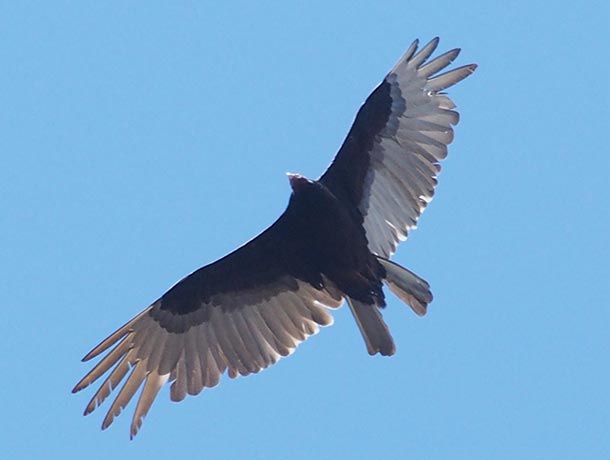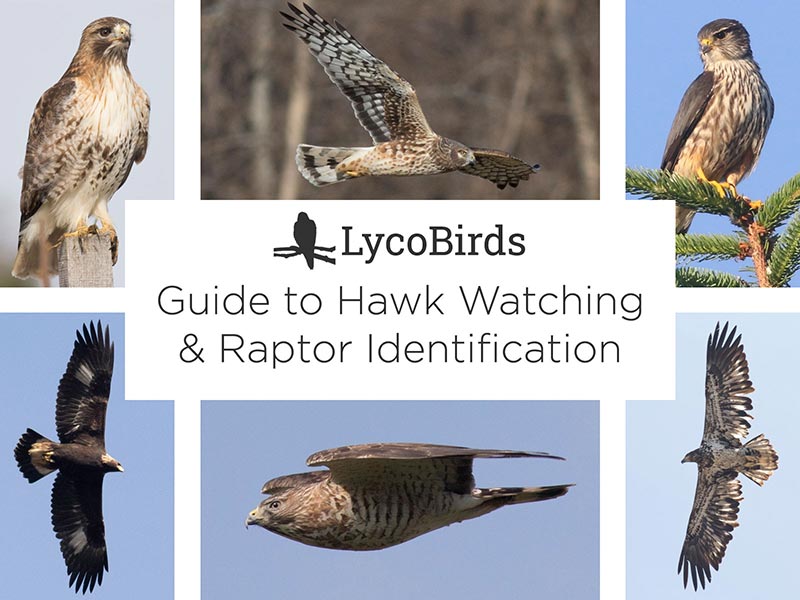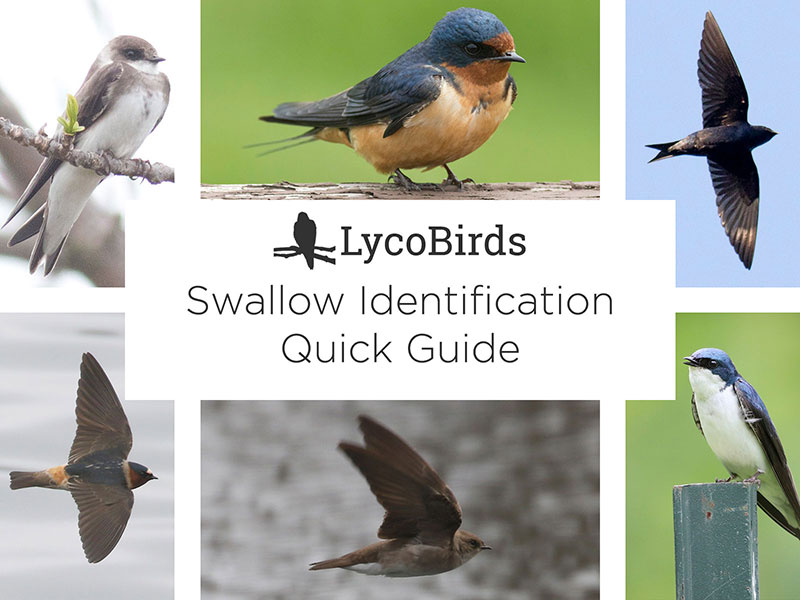Vulture Identification: Turkey Vulture vs Black Vulture
Vultures as a family group are fairly easily recognizable in the eastern U.S. due to their large size, generally dark appearance, and featherless heads. However, there are two different species to consider: Turkey Vulture and Black Vulture. And although separating them is far from the hardest bird ID challenge, there are still some things to watch out for that could trip you up. Keep reading for a overview of identifying them or jump down right to the simple feature-by-feature comparison of the two species.
The New World vultures aren't actually closely related to raptors, but are typically lumped in with them for identification purposes, since their size and flight behavior is similar to raptors — especially eagles. No raptor identification guide would be complete without their inclusion.
Vultures vs Buzzards
Vultures are often colloquially called buzzards, but it is best to avoid using that nickname, because the true buzzard family is the Old World equivalent to our Buteo family of hawks (e.g., Red-tailed Hawk, Red-shouldered Hawk, etc.). Rough-legged Hawk, for example, has a circumpolar range and is called Rough-legged Buzzard in the eurasian part of the range.
Identifying Turkey Vultures
Turkey Vultures are quite large (nearly eagle-sized) and their overall color pattern can be summed up as dark vs light. Specifically, their body and underwing coverts are dark but the flight feathers of the wings and tail are silvery. Although you'll typically see this species from underneath, on the occasions where you see the upperside, it is more uniformly dark with primarily black and brown, without the silvery color seen on the underside of the flight feathers.
They have a relatively long and rounded tail.
Adult Turkey Vultures have a reddish head and pale gray/white bill. Immatures have a darker head, so be careful relying on head color as the key identifying feature. And of course, the head tends to look pretty small because of the lack of feathers. When one is going away from you, sometimes the head and neck look larger and in poor lighting you might mistake this for the head of an eagle, so just be aware of that. When seen up close, they appear to have rather large "nostrils" that you can see through from the side.
Young Turkey Vultures have gray heads and the juveniles in late summer and fall migration have a clean appearance because of the feathers being pretty fresh and uniform in age. Adults often show a jagged appearance to the trailing edge of the wings due to replacing wing feathers, and retaining older worn feathers.

The body and underwing coverts are dark but the flight feathers are silvery

The upperside is more uniformly dark than the underside, with primarily black and brown, and lacking the silvery color seen on the underside

As they mature, Turkey Vultures gain a reddish head and pale gray/white bill

Young Turkey Vultures have gray heads and often have a cleaner wing appearance
Turkey Vulture Flight Characteristics
In flight, Turkey Vultures tend to hold their wings in a V shape, also known as a dihedral. In general, the stronger the wind, the more pronounced this V becomes. They typically seem unsteady when flying, with a teeter or wobble, especially in strong winds. If you see a large dark bird holding its wings in a steep V and teetering, you can be nearly certain that you are looking at a Turkey Vulture.

Turkey Vultures tend to hold their wings in a V shape called a dihedral, and teeter as they fly.
They usually soar and glide more than they flap, but when you do see them flapping, it is deep and slow.
They often fly in groups called kettles. They soar on a thermal to gain altitude then glide to gain distance. Even from a large distance, you can typically tell that they are large dark teetering V-shaped birds.
Identifying Black Vultures
Black Vultures are a bit smaller than Turkey Vultures, but are still fairly sizable birds. They are pretty uniformly dark other than the outer primary feathers that make up the wingtips, which are silvery (think of them as wearing white gloves). You'll note the silvery wingtips on the upperside as well.
Their tails are short and dark, and often fanned, giving a wedge-shaped appearance. The tail is short enough that the "toes" of the bird sometimes extend beyond the tail. And when you add in the shorter wings, it has a much more compact shape than Turkey Vulture.
The head of Black Vulture is gray on all ages.

Very dark plumage overall, except for silvery wingtips

Tails are short and dark, and often have a wedge-shaped appearance

The heads are gray on all ages of Black Vulture

Dark head, black body, silvery wingtips, and a short tail
Black Vulture Flight Characteristics
The typical flight posture for Black Vulture is either flat or a modified dihedral (which is a shallow V-shape that flattens out as you get towards the wingtips).

Here we see two Black Vultures. The left one is holding its wings in a shallow V that flattens out, also called a modified dihedral. The vulture on the right is holding its wings flat. These are typical postures for Black Vultures compared to the steeper dihedral of Turkey Vultures.
Black Vultures have a flap that is quick and somewhat frantic. You almost get the impression that they think they're about to fall out of the sky. They also flap relatively frequently compared to Turkey Vultures.
They also often fly in groups, and the two vulture species will mix.
Comparing the Species
Let's review the major field marks and compare the most useful features for distinguishing Turkey Vultures and Black Vultures.
Head
The head is red on adult Turkey Vultures, and dark gray on immature Turkey Vultures and all Black Vultures.

Turkey Vulture

Juvenile Turkey Vulture, showing a dark head with the large "nostrils" that Black Vultures lack

Black Vulture
Wings
Turkey Vultures have all silvery flight feathers on the underside. Black Vultures only have silvery wingtips.

Turkey Vulture

Black Vulture
Tail
Turkey Vulture has a long silvery tail and Black Vulture has a short black tail.

Turkey Vulture

Black Vulture
Posture
Turkey Vultures tend to have a steeper V shape, compared to the flatter profile of Black Vultures.

Turkey Vulture

Black Vulture
Flapping
Turkey Vultures have a deep, slower flap (think something appropriate for an eagle) while Black Vultures have a quicker, frantic-looking flap (think something appropriate for a Red-shouldered Hawk or Accipiter).
Overhead shape
When gliding high overhead the two species have different shapes. Turkey Vultures are lanky with long wings and tails. Black Vultures are compact with short wings and tails, and the white wingtips are obvious.

Turkey Vulture

Black Vulture
On the ground
When perched or on the ground Turkey Vultures are often quite brown, whereas Black Vultures are black. Also note the difference in the head color and difference in tail lengths (red head, long tail on Turkey Vulture; dark head, short tail on Black Vulture).

Turkey Vultures

Black Vulture
Range
Turkey Vultures are more widespread, especially into the Northeast during the warm months. They are quite migratory, and mostly clear out of the northern end of their range for winter, although some do spend the winter pretty far north (for example, we have some that winter in our area of North-central Pennsylvania). Black Vultures are more common in the Southeastern U.S., but have been gradually expanding northward in the Northeast. They don't really have as much tendency to migrate as Turkey Vultures. Both species also range far south of the U.S. into South America.
Video Overview
Quiz
Practice your vulture identification skills with this quiz.
Other Vultures in North America
The only other vulture species in North America is California Condor.
California Condors are huge birds (larger than eagles). Unfortunately, their population is extremely small and their range is quite restricted. In the eastern U.S., you'll very likely never have to worry about one showing up, and out west you would likely know if you are in one of the few areas where they are present.
Photos of Anomalous Vultures
Given how many vultures you can see while birding and hawk watching, it's not surprising that some anomalies turn up. Here's a collection of some interesting looking vultures we've seen over the years.

Turkey Vulture showing a forked tail due to missing central tail feathers

Turkey Vulture with a few pure white outer primaries on its left wing

A mostly white Turkey Vulture

A tailless Turkey Vulture

Another Turkey Vulture with barely any tail

A Turley Vulture missing a good chunk of feathers in the secondaries

Turkey Vulture with missing primaries in the right wing

A normal Turkey Vulture carrying something, making the head look larger than normal
All photos © David Brown or Bobby Brown.
Like this? Want to help fund more tools and projects on our site?
Support LycoBirds








